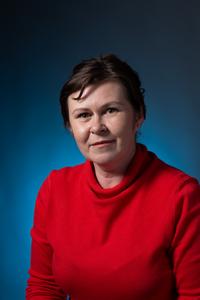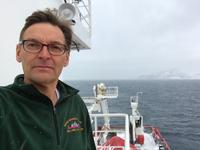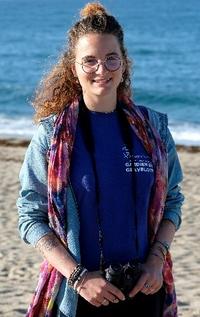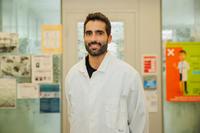SWEDNA - Swedish eDNA lab
Short description
Welcome to the Swedish eDNA (SWEDNA) website.
Most organisms leave trace of DNA in the surrounding environment – so-called environmental DNA (or eDNA). Today, molecular biology has developed sensitive methods, which allow us to discover even the smallest pieces of such DNA traces. Such diagnostic tools can be used to study the population and community structure of habitats as well as presence and absence of particular species of interest.
The Swedish eDNA lab will customize the use of eDNA detection methods for applications in environmental monitoring of aquatic environments.
Welcome to SWEDNA
Welcome to the Swedish eDNA (SWEDNA) website.
Our research
Environmental DNA (eDNA) analysis is a rapid and non-invasive biodiversity tool that is increasingly used in environmental monitoring and biodiversity assessment. It is claimed to be more cost-efficient and more accurate, especially when it comes to detecting rare species, as for e.g. invasive or endangered species. Its main advantage lies in the fact that we do not actually need to see, or collect, the organisms we are monitoring. It is based on the fact that all organisms leave traces of DNA in the environment, to a larger or less degree.
There are many successful applications of eDNA approaches in environmental monitoring today, but some important methodological questions remain until these methods can be implemented in national monitoring program. These questions are addressed by this project, and include, among others:
- How far from the source can we detect DNA in various aquatics systems and for various groups of organisms?
- How long can we successfully detect eDNA in the marine environment and for various groups of organisms?
- What is the risk of false positives, i.e. detecting DNA from an organism not present in the system?
- How can we optimize sampling and filtering techniques to yield maximum possible amounts of DNA?
- Can we estimate population sizes from eDNA results in various groups of organisms?
- How does eDNA detection perform in comparison to alternative methods such as metabarcoding and microscope-based identification
- What is the statistical power in eDNA identification and how should eDNA studies be statistical designed
Research projects
During the course of this project we will perform a series of field and laboratory experiments to investigate important methodological questions in detail. These include:
1. How far from the source can we detect DNA?
Different organisms leave different amounts of DNA traces in the water, depending on size, movement patterns, their general biology, as well as the environmental conditions. There are many studies of eDNA for monitoring fish communities, but the picture is not equally clear when it comes to other taxonomic or ecological groups. For example, how well can we trace hard-shelled organisms like crustaceans, or very small molluscs? In addition, most eDNA trace studies have been carried out in freshwater systems, which are more enclosed than open marine environments. Hence, we will perform experiments also in coastal habitats.
2. Rate of DNA degradation in aquatic environments, and the risk of "false positives"
Decay rates for eDNA often depend on the environmental conditions, which are principally different in freshwater and marine systems. To better understand the variation in decay rates among different organisms and environments, we will perform ddPCR analyses with fish, molluscs and arthropods in a controlled coastal field study across seasons and a range of environmental gradients.
3. The effect of filtering, fixatives, and extraction procedures
Few studies have systematically investigated the effect of different filtration and fixation methods for eDNA and we will carry out some tests to optimize pre-filtering and fixation protocols. These protocols should not only be adjusted to improve the eDNA yield, but also allow easy integration into existing monitoring practice.
4. Sampling strategies in general, and the detecting of rare species in particular
Few theoretical studies have been performed to date to investigate the effect of abundance, spatial distribution, patchiness, and sampling effort on the successful detection of eDNA traces. We will address this issue with a series of modelling and experiments in order to simulate and optimize our sampling strategies for various groups and environments.
5. Quantification and population size estimates
Some pioneering studies have shown that it is possible to deduct population size and structure from eDNA. We will explore this application further and conduct experiments to investigate the applicability of eDNA in monitoring population sizes of endangered species in Sweden.
6. SweDNA partner in new Horizon European project called MARCO BOLO
Here we will implement autonomous technology for DNA-based biodiversity monitoring throughout Europe and make sure technology, data streams, and experts networks are harmonized to establish eDNA as a standard tool for biodiversity assessments in the future. The project runs 2023-2026. Website: https://marcobolo-project.eu/
7. SweDNA partner in Digital Twin Ocean for biodiversity
The digital Twin Ocean (DTO) will transform access to data on ocean biodiversity and the human activities that impact them, enabling the sustainable integration of these data flows including genomics data for the benefit of society. The DTO will develop a the digital replica of marine ecological processes, bringing together data, models and new algorithms supporting the development of policy-relevant tools and services for effective monitoring, restoration, and protection of marine biodiversity.
Reference group
Sara Peilot (Vänerns vattenvårdsförbund)
Carin Nilsson (Medins Havs och Vattenkonsulter AB)
Johanna Bergkvist (Marine Monitoring AB)
Patrik Bohman (SLU, Uppsala)
Malin Strand (SLU, Artdatabanken)
Cecilia Andersson (Stena Line Maritime Sector)
Erland Lettevall (Swedish Agency for Marine and Water Management)
Vacant (Swedish Environmental Protection Agency)
Social Media
Results
Daraghmeh (2025) A Long- Term Ecological Research Data Set From the Marine Genetic Monitoring Program ARMS-MBON 2018–2020. https://doi.org/10.1111/1755-0998.14073
Pagnier et al (2025) Using the long-term genetic monitoring network ARMS-MBON to detect marine non-indigenous species along the European coasts. https://doi.org/10.1007/s10530-024-03503-2
Cecchetto M, Dettai A, Gallut C, Obst M et al (2024) Seasonality of primary production explains the richness of pioneering benthic communities. Nature Communications 15, 8340 (2024). https://doi.org/10.1038/s41467-024-52673-z
Daraghmeh N (2024). ARMS-MBON 18S rRNA and COI gene metabarcoding: scanning for non-indigenous species. protocols.io. https://dx.doi.org/10.17504/protocols.io.n92ldmmmnl5b/v1
Sundberg, P., Axberg, A., Daragmeh, N., Wengström, N., & Panova, M. (2024). Monitoring of Endangered Freshwater Mussels in Sweden Using Digital PCR. Environmental DNA, 6(6), e70046.
L Green, TG Dahlgren, A Axberg, M Panova, M Obst, P Sundberg (2024) Monitoring of the invasive round goby in an estuarine seascape based on eDNA. bioRxiv, 2024.05. 06.592655, doi: https://doi.org/10.1101/2024.05.06.592655
Hablützel, P. I., Martinez Arbizu, P., Bilsen, A., Christodoulou, M., Delacauw, S., Deneudt, K., Khodami, S., Lagaisse, R., Heynderickx, H., Obst, M., Sapkota, R., Sundberg, P., Uhlir, C., Stæhr, P. A., & Winding, A. (2024). DNA-based monitoring of Non-Indigenous Species (NIS). Interreg North Sea Region. https://www.geans.eu/sites/geans.eu/files/managed/GEANS_Pilot%20NIS_copy.pdf
Bravell F (2020) Vilka faktorer är viktiga vid eDNA provtagning? B.Sc. thesis in Marine Sciences, Supervisor Marina Panova. Dpt of Marine Sciences, University of Gothenburg
Obst M, Sundberg P, Reiss H, Lagaisse R, De Backer A, Deneudt K, Staehr PAU (2023) DNA-based monitoring: A pilot study on autonomous reef monitoring structures (ARMS) in the North Sea region. Pilot report 3. INTERREG program GEANS– Genetic tools for Ecosystem health Assessment in the North Sea region. Available at https://www.geans.eu/outreach/reports
Dorup T (2023) The use of regurgitated pellets from the great cormorant to detect the presence of the round goby. BSc Degree report. University of Gothenburg, Available at GUPEA.
Morin F, Panova M, Schweizer M, Wiechmann M, Eliassen N, Sundberg P, Cluzel-Burgalat L, Polovodova Asteman I (2023) Hidden aliens: Application of digital PCR to track an exotic foraminifer across the Skagerrak (North Sea) correlates well with traditional morphospecies analysis. Environ Microbiol. https://doi.org/10.1111/1462-2920.16458
Santi et al (2023) European marine omics biodiversity observation network: a strategic outline for the implementation of omics approaches in ocean observation. Front. Mar. Sci. 10:1118120. doi: 10.3389/fmars.2023.1118120
Morin et al (2023) Hidden aliens: Application of digital PCR to track an exotic foraminifer across the Skagerrak (North Sea) correlates well with traditional morphospecies analysis. Environ Microbiol. https://doi.org/10.1111/1462-2920.1645
Dorup T (2023) The use of regurgitated pellets from the great cormorant to detect the presence of the round goby. BSc project report. Spring 2023
Martaeng R, Obst M & Kuklinski P (2023) Phylogeographic study using autonomous reef monitoring structures indicates fast range expansion of the invasive bryozoan Juxtacribrilina mutabilis. Hydrobiologia . https://doi.org/10.1007/s10750-023-05184-9
Huertas-Olivares C, Basset A, Exter K, Kotoulas G, Fiore N, Portier M, Meyer R, Schaap D, Santi I, Obst M, Vermeulen A, Thijsse P, Pade N, González-Aranda J M, López J, Minadakis N, Vaira L, Pavloudi C, and Arvanitidis C (2023) Accelerating the research on Biodiversity and Ecosystems: Best Practice on Climate Change vs Non-Indigenous Invasive Species (NIS), EGU General Assembly 2023, Vienna, Austria, 24–28 Apr 2023, EGU23-15298, https://doi.org/10.5194/egusphere-egu23-15298.
Abreu A, Bourgois E, Obst M, …et al (2022) Priorities for ocean microbiome research. Nature Microbiology 7 (937–947). https://doi.org/10.1038/S41564-022-01145-5
Sundberg P, Axberg A, Daragmeh N, Panova M, Obst M (2022) Genetic methods in environmental monitoring: Early detection and monitoring of non-indigenous species based on DNA. Report to the Swedish Agency for Marine and Water Management 2022:4. ISBN: 978-91-89329-32-4
PAU Staehr, K Dahl, H Buur, C Göke, R Sapkota, A Winding, M Panova, et al (2022) Environmental DNA Monitoring of Biodiversity Hotspots in Danish Marine Waters. Frontiers in Marine Science 8:800474. doi: 10.3389/fmars.2021.800474
I Santi, R Casotti, T Comtet, M Cunliffe, Y Koulouri, L Macheriotou, F Not, et al (2022) European Marine Omics Biodiversity Observation Network (EMO BON) Handbook. http://dx.doi.org/10.25607/OBP-1653
Hestetun, J. T., Lanzén, A., Skaar, K. S., & Dahlgren, T. G. (2021). The impact of DNA extract homogenization and replication on marine sediment metabarcoding diversity and heterogeneity. Environmental DNA https://doi.org/10.1002/edn3.223
Hestetun, J. T., Lanzén, A., & Dahlgren, T. G. (2021). Grab what you can—an evaluation of spatial replication to decrease heterogeneity in sediment eDNA metabarcoding. PeerJ, 9, e11619 https://doi.org/10.7717/peerj.11619
M Obst, K Exter, AL Allcock, C Arvanitidis, A Axberg, M Bustamante, ... Sundberg P,…(2020) A marine biodiversity observation network for genetic monitoring of hard-bottom communities (ARMS-MBON) Frontiers in Marine Science 7: https://www.frontiersin.org/articles/10.3389/fmars.2020.572680/full
Sundberg, P., Panova, M., Strand, M. & M. Svensson. 2020. eDNA och fiskinventeringar - ställ krav på rapporterna. Fauna & Flora 115:4
Hestetun, J., Lanzén, A., Skaar, K., & Dahlgren, T.G. (2020). The impact of DNA extract homogenization and replication on marine sediment metabarcoding diversity and heterogeneity. Authorea Preprints.
Felix Bravell (2020) Vilka faktorer är viktiga vid eDNA provtagning? B.Sc. thesis in Marine Sciences, Supervisor Marina Panova. Dpt of Marine Sciences, University of Gothenburg
Exter K, Decruw C, Portier M, Gerovasileiou V, Pavloudi C, Obst M (2020) Genomics Observatory Use-Case: The challenge to standardise image and sequence data to Darwin Core format. Biodiversity Information Science and Standards 4: e58938
doi: 10.3897/biss.4.58938
Pavloudi, C.; Chrismas, N.; Troncoso, J.S.; Norkko, J.; Viard, F.; Mortelmans, J.; Mavric, B.; Gerovasileiou, V.; Arvanitidis, C.; Kotoulas, G.; Obst, M. (2019) Artificial Reef Monitoring Structures (ARMS) providing insights on the marine biodiversity and community structure. http://www.eurobis.org/imis?module=ref&refid=311999
Kutti T, Johnsen IA, Skaar KS, Ray JL, Husa V and Dahlgren TG (2020) Quantification of eDNA to Map the Distribution of Cold-Water Coral Reefs. Front. Mar. Sci. 7:446. doi: 10.3389/fmars.2020.00446
Hestetun JT, …Dahlgren T (2020) Significant taxon sampling gaps in DNA databases limit the operational use of marine macrofauna metabarcoding. Marine Biodiversity 50:70 https://doi.org/10.1007/s12526-020-01093-5
Sundberg P, Liungman M (2019) Övervakning av flodpärlmussla med eDNA – en pilotstudie. Rapport till Länsstyrelsen i Jönköpings län. version 1.2. Projektnr. 3343.
Bohman P, Sundberg P, Klint M, Obst M (2018). Jakten på solabborren (Lepomis gibbosus) - en eDNA-studie i Kungsbackaån. Drottningholm Lysekil Öregrund: (NL, NJ). Department of Aquatic Resources, Sveriges lantbruksuniversitet. Aqua Reports 2018:21. https://pub.epsilon.slu.se/15801/
Sundberg, P., Obst, M., Bourlat, S., Bergkvist, J. & M. Magnusson, (2018). Utvärdering av ny övervakning av främmande arter. (Evaluation of new ways to monitor alien species). Swedish Agency for Marine and Water Management Report 2018:24 55 pp. https://www.havochvatten.se/hav/uppdrag--kontakt/publikationer/publikationer/2018-08-23-utvardering-av-ny-overvakning-av-frammande-arter.html
Dnyansagar R, Zimmermann B, Moran Y, Praher D, Sundberg P, Friis-Møller L, Technau U (2018) Dispersal and speciation: The cross Atlantic relationship of two parasitic cnidarians. Molecular Phylogenetics and Evolution 126 (346-355) https://doi.org/10.1016/j.ympev.2018.04.035
Sundberg, P., M. Berggren & T. Dahlgren (2017). Test av eDNA och ddPCR som metod för att upptäcka/övervaka invasiva främmande arter (IAS): svartmunnad smörbult och blåskrabba. Rapport till Havs- och vattenmyndigheten.
Sundberg, P., Q. Haenel & S. Bourlat (2016). Utvärdering av DNA-streckkodning och referensbibliotek för övervakning av invasiva främmande arter. Rapport till Havs- och vattenmyndigheten.
Members
Per Sundberg
Project tasks: Principal investigator, Project coordinator
Per Sundberg is an expert in eDNA technology, marine biodiversity, and the IMO Ballast water convention. He is CEO for an environmental consultancy company offering eDNA services. He has a long-standing experience as project coordinator, principal investigator, and authors of reports and scientific papers.
Competence: marine biodiversity and conservation, monitoring of red-listed, alien, and invasive species ecological modelling, IMO Ballast Water Convention, Biological risk assessments, marine field work

Marina Panova
Project tasks: Planning, data analyses and synthesis.
Marina Panova works with various aspects of genomics in the sea: from de novo genome projects for target species to metabarcoding and metagenomics of marine communities. She is an expert in applying NGS tools to non-model hard-to-sequence organisms. Her main research interests are evolution of genes and genomes, development of genomic tools and recently, eDNA applications in biodiversity and monitoring.
Competence: evolutionary biology, population genomics, transcriptomics, metabarcoding, bioinformatics, statistics.

Matthias Obst
Project tasks: Communication, liaison, networking, data management
Matthias Obst works with biodiversity modelling, especially for alien, invasive, and endangered species. He is also expert in testing genetic observation systems for biological diversity in the ocean, so-called genomic observatories. Obst leads several programs to establish early warning systems and monitoring networks for marine invasive species based on DNA methods, including to the European ARMS-program and ARMS pilot in the INTERREG program GEANS.
Competence: marine biodiversity and conservation, monitoring of red-listed, alien, and invasive species ecological modelling, IMO Ballast Water Convention, Biological risk assessments, marine field work, biodiversity informatics

Thomas Dahlgren
Project tasks: Planning, field work, and synthesis
Thomas Dahlgren is a molecular taxonomist expert on marine invertebrate taxa. He has a long working experience in the field of monitoring impact from activities such as oil and gas exploration, aquaculture and deep-sea mining. Thomas Dahlgren is part time employed at GU. His main employer is NORCE in Bergen, Norway.
Competence: molecular taxonomy, marine ecology, deep-sea biodiversity, connectivity and population genetics, marine biodiversity and conservation, marine field work

Justine Pagnier
Justine Pagnier, visiting student, is a marine biologist, passionate about benthic invertebrates and biodiversity preservation. She holds a master's degree in Conservation Biology from Lund University. She worked between France, Sweden and Portugal, with a focus on Marine Protected Areas and genomic tools as a monitoring method.

Joel Hjärne Kokk
Joel Hjärne Kokk is a master's student in marine biology. Joel's thesis will be on genetic analyses of biodiversity in the Kosterhavets Nationalpark.

Nauras Daraghmeh
Visiting student Nauras Daraghmeh has a strong interest in marine molecular ecology and its applications for conservation practices.
Using Autonomous Reef Monitoring Structures (ARMS) and DNA metabarcoding, he is investigating coral reefs and other marine ecosystems in regards to biodiversity, inter-species networks, phylogeography, and non-indigenous species.
He is also looking to further extend my knowledge and skills in the field of genomics, bio-/phylogeography, molecular markers and bioinformatics.

Tim Dorup
Tim Dorup is a student in the Bachelor’s programme in Biology at the University of Gothenburg with a great passion for the ocean and marine wildlife. He currently works on his bachelor’s thesis where he investigates whether DNA from the great cormorant’s (Phalacrocorax carbo) regurgitated pellets can be used to detect the spread of the invasive species round goby (Neogobius melanostomus).
About project
Project title: Can regurgitated pellets from the great cormorant (Phalacrocorax carbo) be used to detect the spread of the invasive species round goby (Neogobius melanostomus)?
One of the major threats to biodiversity and ecosystem services today is the spread of invasive species. In Sweden, one invasive species of concern is the round goby (Neogobius melanostomus).
This pilot study aims to investigate the feasibility of using DNA extracted from regurgitated pellets of the great cormorant (Phalacrocorax carbo) to detect and map out the spread of the round goby. The regurgitated pellets will be collected from islands along the Swedish west coast and analyzed using dPCR to identify the presence of round goby DNA.
Based on the radius of the great cormorant’s foraging area, the spread of the round goby will be estimated. If this method proves to be effective, it may be used as an additional method to facilitate the mapping of invasive species and contribute to future conservation efforts.

